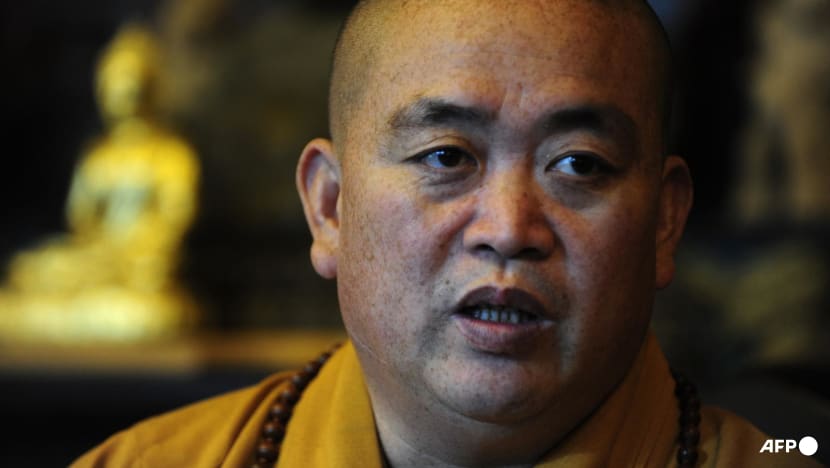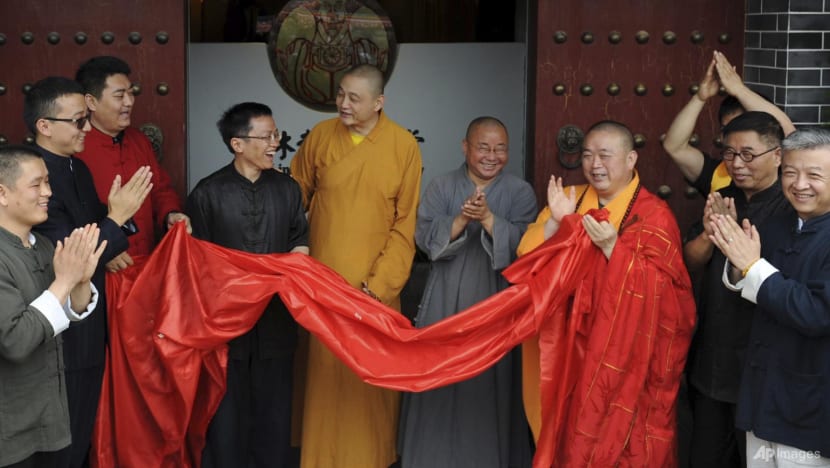Head of China’s world-famous Buddhist sanctuary Shaolin Temple under criminal investigation
The temple also accused Shi Yongxin of maintaining improper relationships with multiple women for a long time and having illegitimate children.

The abbot of Shaolin Temple, Shi Yongxin, speaks at the famous temple in Henan province on Nov 8, 2009. (File photo: AFP/Peter Parks)

This audio is generated by an AI tool.
The abbot of China’s famous Shaolin Temple is under investigation for criminal offences, including embezzling project funds and temple assets, according to a statement released by the Buddhist sanctuary on Sunday (Jul 27).
Shi Yongxin, head of one of the most famous Buddhist monasteries in the world, is suspected of seriously violating Buddhist precepts and is currently under joint investigation by multiple departments, the statement added.
The temple also accused Shi of maintaining improper relationships with multiple women for a long time and having illegitimate children, and promised to release more details to the public in a timely manner.
Shaolin Temple, established more than 1,500 years ago in central China’s Henan province, is the birthplace of Zen or Chan Buddhism and a Unesco World Heritage site. The renowned monastic institution set among the Songshan Mountains is also recognised as the cradle of Shaolin kung fu.
Shi, 60, is one of China’s most well-known monks and became head of the Shaolin Temple in 1999. The MBA degree-holder earned the nickname of “CEO monk” because of his excessive commercialisation of the temple’s heritage and influence.
In 2006, he was criticised for accepting a luxury car from the local government in recognition of his contribution to tourism.
No stranger to controversy, Shi was also suspected of involvement in fraud and sexual misconduct 10 years ago.
In March 2015, he and the temple were criticised for their plan to build a US$297 million hotel complex in Australia, which would include a temple, a live-in kung fu academy, and a golf course.
In July of that year, he was accused by a former disciple of fathering several children out of wedlock and of embezzling funds. Henan provincial religious authorities dropped the charges in 2017 citing insufficient evidence.

Shi has also served as president of the Henan Provincial Buddhist Association since 1998 and was a deputy to the National People’s Congress from 1998 to 2018.
News of the investigation into Shi was trending on Chinese social media platform Weibo on Sunday.
Rumours surrounding his whereabouts had in fact gained traction since Saturday, when unverified social media posts claimed he had been taken away for investigation.
Shi has had an active Weibo account since 2018 – averaging 1.5 posts per day and attracting over 870,000 followers. But he has not posted anything since Thursday.
According to a Jul 8 post on the Shaolin Temple’s official website, Shi’s last public appearance was when he attended a meeting of monks the previous day.
Chinese newspaper Economic Observer reported that Shi had been taken away on Friday by police in Xinxiang, an industrial city in northern Henan.
Shi has faced significant criticism from both Buddhist and martial arts communities for transforming the Shaolin Temple into a commercial enterprise and operating it much like a modern business during his nearly three decades as abbot, with interests spanning publishing, film and television and medicine.
Under his management, Shaolin has also expanded globally, establishing more than 50 “Shaolin Cultural Centres” overseas.
Shi is currently associated with eight institutions, according to business information inquiry website Qichacha. Three of them are still operational, including Shaolin Temple, while five companies have already been deregistered.
In 2010, the historic architectural complex including the Shaolin Temple was officially added to the Unesco World Cultural Heritage List.
This article was first published on SCMP.















